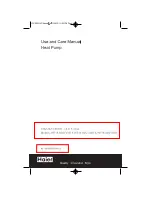
27
26
Operation and maintenance instructio
ns – CLASS UNIT TAC5
Operation and maintenance instruction
s – CLASS UNIT TAC5
Modbus configuration
The MODBUS RTU communication requires an additional
satellite circuit (CID050043) which is used as commu-
nication interface. The communication protocol used is
MODBUS RTU, RS485.
Setting
Settings
range
Factory
setting
Adress
1...247
1
Baudrate
1200
4800
9600
19200
9600
Parity
No
Yes
No
LAN configuration
The MODBUS TCP/IP communication requires an addi-
tional satellite circuit (CID025072) which is used as com-
munication interface. The communication protocol used
is Modbus TCP/IP on Ethernet network over twisted pair
10 BASE T/100Base-TX IEEE 802.3.
Setting
Settings
range
Factory
setting
IP configuration
DHCP
Manual
Manual
IP adress
192.167.1.1
Netmask
255.255.255.0
Gatway
0.0.0.0
Operating time
For maintenance purposes, operating timers can be acti-
vated. If the “service alarm time” or the “Stop fan” timers
are triggered, the according alarm will be shown and the
unit will switch to “OFF”-mode.
Setting
Settings
range
Factory
setting
Reset timer
No
Yes
No
Fan run time activation
No
Yes
No
Display time
No
Yes
No
Service alarm time
0...999999h
0h
Stop fan
0...999999h
0h
0-10V output
The controller has as a standard feature two configur-
able analogue 0...10V outputs. The outputs represent the
actual airflow (or torque) or the actual pressure delivered
by one of the selected fans.
Setting
Settings
range
Factory
setting
Output 1
Flow Fan 1
Pressure Fan 1
Flow Fan 2
Pressure Fan 2
Flow Fan 3
Pressure Fan 3
Flow Fan 4
Pressure Fan 4
Torque Fan 1
Torque Fan 2
Torque Fan 3
Torque Fan 4
Flow Fan 1
Output 2
Flow Fan 1
Pressure Fan 1
Flow Fan 2
Pressure Fan 2
Flow Fan 3
Pressure Fan 3
Flow Fan 4
Pressure Fan 4
Torque Fan 1
Torque Fan 2
Torque Fan 3
Torque Fan 4
Pressure Fan 1
Attention :
before handling and/or opening the access panels it is compulsory to shut down the unit. Do not
isolate the power supply whilst the unit is running. If KWin and\or KWout are installed, then isolate the corres-
ponding power supplies.
Regular maintenance is essential to guarantee good operation of the air handling unit and a long service life.
The maintenance frequency will depend on the application and on the actual environment conditions but the following are
general guidelines:
Replace the filters with a kit of replacement filters.
- Check for any alarms indicated on the control device. In case of an alarm refer to troubleshooting section.
- Check the state of filter clogging. The control device allows a pre-defined ‘filter alarm’ threshold to be set.
Replace filters if necessary. Filters that are too clogged can generate the following problems:
- Insufficient ventilation
- Excessive increase of fan rotation speed
- Excessive sound levels
- Excessive power consumption (power consumption will increase exponentially to an increase
in pressure drop, for a constant airflow)
- Unfiltered air passing through the heat exchanger (risk of clogging) and into ventilated rooms.
The list of replacement filter kits for each unit can be downloaded from our website.
- To locate the filter, refer to schemas on point 2.0.
- Inspection and cleaning of the inside of the unit:
• Vacuum clean any accumulations of dust in the unit.
• Inspect and gently vacuum clean the heat exchanger if necessary. Use a brush to protect the fins.
• Clean any condensation stains
• Clean any accumulations in the drain pan.
6.1 ONCE THE UNIT OPERATES IN NORMAL CONDITION
6.2 EVERY 3 MONTHS
6.0 Preventive maintenance
































